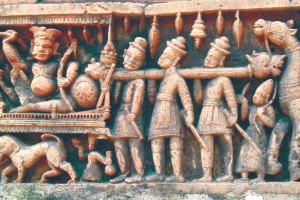| Home - Back Issues - The Team - Contact Us |
 |
| Volume 10 |Issue 37 | September 30, 2011 | |
|
|
Heritage The Past in Terracotta HASIBUR RAHMAN BILU
Several hundreds of eye-catching terracotta plaques of different dynasties are being ruined. These include “Somapura Maha Vihara” in Naongoan and some other important archaeological sites such as “Kantaji Temple” in Dinajpur of northern Bangladesh. According to the Department of Archeology Bangladesh officials, most of the terracotta in Somapura Maha Vihara, “Kantaji Temple,” Puthia Temples in Rajshahi, Jorbangla Temple in Pabna and some other archeological sites have been damaged because of the high salinity in the soil, heavy rainfall and lack of maintenance. Although the Bangladesh government and UNESCO are supposed to be working together to protect terracotta plaques, they have achieved little success. “Climate changing and sea level raising seriously hampered terracotta protective works,” says Md Abdul Khaleque, Regional Director (RD) Dhaka, Division. Rising sea level has been one of the main causes increasing the saline zone in the soil, he adds. A huge number of terracotta have been damaged or ruined due to high salinity in the soil and natural calamities. “We have to keep 1810 terracotta in store room to save though more than 400 terracotta of Pala Dynasty as in-situ of the temple,” says Md Mahabub-ul-Alam, Assistant Director (AD) of the department and custodian, Somapura Maha Vihara site. Somapura Maha Vihara, the oldest university in Asia was built by the Pala king Dharmapala in 770 AD-810 AD. According to the documents the University used to teach theology, grammar, logic, philosophy, fine arts and visited by famous scholars. The residential university enrolled students free of cost; even room and board were free. About one hundred adjacent villages supplied food and clothing for about 2,000 students living in the university premise. Most of the students came from south-east Asian countries like Korea, Mongolia, China and Tibet to receive the superior quality of education.
The site was first noticed by Buchanon Hamilton during his survey in Eastern India in between 1807 to 1812. Archeologist Sir Alexander Cunningham also visited the site in 1879, he intended to carry out excavation in the mound but he had to be satisfied with limited excavation because he was prevented by the land owner Balihar Zamindar. The site was declared protected by the Archeological Survey of India in 1919 under Ancient Monuments Preservation Act of 1904. UNESCO declared the site as world heritage in 1985. According to the archeological documents there are in all 177 cells, excluding the cells of the central block in each direction; 45 cells on the north and 44 in each of the other three sides. The 31-metre high temple was built using 11 hectares of land.
The Kantaji Temple in Dinajpur is one of the most beautiful old structures in South Asia and is fully covered with terracotta plaques. Hundreds of terracotta of the temple have been damaged because of high salinity, apathy and neglect of the department of archeology. The temple was built in 1704-1752 AD by Maharaja Prannath renewed Zaminder in Dinajpur and his adopted son Ramnath. The 50-ft square three-storied brick built temple was declared as protected in 1960 by the department of archeology. Thousands of terracotta plaques still carries Hindu mythology like Ramayana, Mahabharata though the temple was damaged in an earthquake in 1897. The Pakistan Army also tried to destroy the temple during the Liberation War. In general, the pattern of terracotta decoration of the temple's outer walls, the lowest four basal panels, running parallel across the four faces, depict from bottom upward, immediately above the plinth. Most of the terracotta still have human figures along with decorative motifs. The Puthia Temple Complex in Rajshahi district is one of the important archeological sites in the country especially for its eye-catching terracotta. The highly decorated temples in the complex were built by Hindu Zamindars, Rajas of Puthia Raj family who were noted philanthropists of Rajshahi. The ornamental temple built in 1815 by the Puthia Queen is the large Shiva temple in Bangladesh. The temple suffered damage during the Liberation War in 1971. The protective monument lost its shine like other temples in the complex due to lack of maintenance. The Govinda Temple is one of the beautiful structures in the complex which was erected between 1823 and 1895 by one of the maharanis of the Puthia estate. A huge number of terracotta plaques of the temples were ruined because of the high salinity in the soil. The brick built “Jorbangla Temple” in Pabna was decorated using ornamental terracotta and bricks in 1800 AD according to archeological documents. Like the Kantaji Temple, the temple was damaged in a serious earthquake in 1897. But the temple still stands with many of its beautiful terracotta plaques and decorated bricks. The temple is believed to have been built by the employee of the Marshidbad Nawab Brojo Mohon Cowri. The terracotta plaques of these ancient structures are reminders of lost civilisations, the architecture of which is evidence of the high quality of craftsmanship and masonry. Preserving these temples and their decorative terracotta plaques is an undeniable responsibility of the nation as a whole.
Copyright
(R) thedailystar.net 2011 |
||||||||||||



